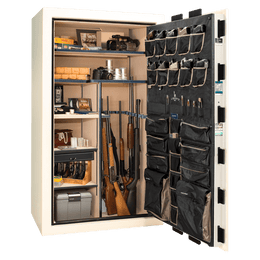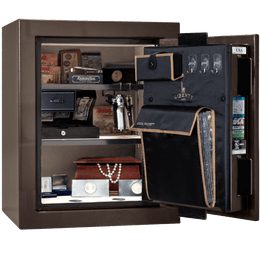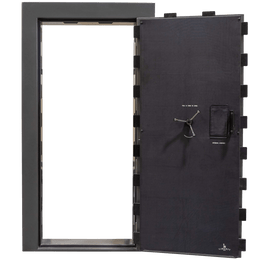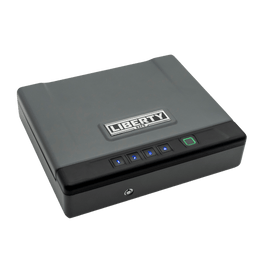Ensuring Year-Round Protection: A Guide to Seasonal Safe Care
As the crisp autumn air arrives and leaves begin to turn, it signals a change not just in scenery but also in the environment inside our homes. Fluctuating temperatures and shifts in humidity can create unforeseen challenges for the security and longevity of your safe and its precious contents. Just as you'd prepare your home for the coming winter, your safe requires seasonal attention to ensure it continues to function flawlessly. Proactive fall maintenance is a critical step in protecting your firearms, documents, and valuables from the hidden dangers of moisture and cold, guaranteeing they remain secure no matter the weather.
Why Seasonal Changes Demand Your Attention
The transition from warm to cool weather introduces a significant threat: condensation. When your central heating turns on, the warm, moist indoor air comes into contact with the cool, dense steel of your safe. This temperature difference can cause moisture to condense on the interior walls and contents of the safe, creating an ideal environment for rust and mildew. Firearms are particularly vulnerable to rust, which can compromise their function and value. Important documents can become warped or damaged by mildew, and even jewelry can be affected. A high-quality safe, like those in the Colonial Series, is built to last, but environmental factors still require management. Proper fall maintenance ensures the internal climate of your safe remains stable and dry, preserving the integrity of both your safe and the items you've secured within it.
The Science Behind Humidity and Your Safe
Understanding relative humidity is key to effective safe care. When the temperature drops, the air’s capacity to hold water vapor decreases, causing relative humidity to rise. This is why a cool basement often feels damp. Your safe acts as a microcosm of this effect. The door seals designed for fire protection are incredibly effective at keeping heat out, but they also trap air and moisture inside. Without proper moisture control, this trapped humid air can condense and cause damage over the fall and winter months. Implementing a reliable dehumidifying system is not just a suggestion—it's an essential component of responsible safe ownership.
Did You Know?
- A single 10°F drop in temperature can double the relative humidity inside an enclosed space like a safe if moisture is present.
- The heavy steel of a quality safe acts as a 'thermal mass,' meaning it heats up and cools down much slower than the surrounding air, making it a prime surface for condensation to form.
- Paper, photo albums, and firearm cases can carry moisture into your safe, acting like sponges that slowly release humidity over time.
- Electronic lock batteries can drain up to 20% faster in colder temperatures, making a fall battery change a smart, preventative measure.
Your Essential Fall Safe Maintenance Checklist
Follow these steps to ensure your safe is ready for the changing seasons and continues to provide the ultimate protection you rely on from Liberty Safe.
1. Inspect and Refresh Your Dehumidifier
Your first line of defense against moisture is a quality dehumidifier. If you use a desiccant-style canister or bag, fall is the perfect time to "recharge" it by baking it in an oven according to the manufacturer’s instructions. If you have an electric rod-style dehumidifier, ensure it is plugged in and working correctly. A small, inexpensive hygrometer placed inside your safe can help you monitor humidity levels, which should ideally be kept below 50%.
2. Test and Replace Batteries in Electronic Locks
Cold weather is notorious for weakening battery performance. Avoid the inconvenience of a lockout by proactively replacing the battery in your electronic lock. Use a high-quality, brand-name 9-volt alkaline battery. It’s a simple, inexpensive task that can save you a major headache later. For specific instructions, you can view tutorials like this guide on how to change the battery on a SecuRam lock.
3. Lubricate the Locking Mechanism
Cold can cause the grease in locking bolts and hinges to stiffen, making the handle harder to turn. To prevent this, apply a small amount of silicone-based lubricant or white lithium grease to the safe's locking bolts and hinge points. Extend the bolts and wipe them clean before applying a fresh, thin coat. This ensures smooth operation all winter long. Always refer to your safe’s use and care guide for specific recommendations.
4. Inspect the Door Seal
Check the integrity of the heat-activated Palusol® door seal around the frame. Ensure it is not cracked, peeling, or damaged. This seal is crucial for fire protection and also helps create a barrier against dust and fluctuating humidity. A clean, intact seal performs better year-round.
5. Organize for Airflow
A crowded safe restricts air circulation, creating pockets where moisture can accumulate. Take a few minutes to organize the contents, ensuring there is space between items. Using organizational accessories like an AR-15 Mag Holder or rifle rods can help maximize space and improve airflow, allowing your dehumidifier to work more effectively.
Comparison of Humidity Control Solutions
| Solution Type | How It Works | Best For | Maintenance |
|---|---|---|---|
| Desiccant Dehumidifiers | Silica gel beads absorb moisture directly from the air. Color-changing indicators show when saturation is reached. | Smaller safes or areas without access to an electrical outlet. | Requires periodic "recharging" by heating in an oven to release trapped moisture. |
| Electric Rod Dehumidifiers | Gently warms the air inside the safe. The slightly warmer air circulates, preventing condensation from forming. | Larger safes and situations requiring consistent, long-term humidity control. | Set it and forget it. Requires an electrical outlet inside or near the safe. Check periodically to ensure it is working. |
A National Approach to Local Climates
Across the United States, fall brings different challenges. In the Northeast and Midwest, drastic temperature drops mean indoor heating systems work overtime, elevating the risk of condensation inside your safe. In the humid Southeast, outdoor moisture levels remain high, making a powerful dehumidifier essential. Even in the arid Southwest, significant day-to-night temperature swings can create conditions ripe for moisture. No matter your location in the U.S., these fall maintenance tips are universally applicable and vital for protecting your assets.
Have Questions About Your Safe's Maintenance?
Proper care is the key to a lifetime of security. If you have questions about maintaining your safe or are considering an upgrade for enhanced protection, our expert team is here to help.
Contact Our Experts TodayFrequently Asked Questions (FAQ)
Q: How often should I check my safe's dehumidifier?
A: A monthly check is ideal, especially for rechargeable desiccant types. For electric rods, a quick check every month ensures it's still operational. At a minimum, service your dehumidifier with every change of season.
Q: Can I place my safe in a garage or basement?
A: Yes, but be aware that these unconditioned spaces are prone to much higher humidity and more extreme temperature fluctuations. In these locations, using a high-capacity dehumidifier like an electric rod is critical. Proper home installation and anchoring is also paramount for security.
Q: What should I do if my electronic lock is beeping or not responding?
A: Beeping is almost always a low battery warning. If the lock is unresponsive, the battery is likely dead. Replace it immediately with a new, high-quality 9V alkaline battery. If problems persist, consult the troubleshooting guide or contact customer service.
Q: What lubricant is safe for my lock mechanism?
A: We recommend a high-quality silicone spray or white lithium grease. Avoid products like WD-40, as they are solvents that can attract dust and eventually gum up the delicate components of the lock and boltwork. Always refer to your owner's manual for specific product recommendations.
Glossary of Terms
Relative Humidity
The measure of water vapor in the air, expressed as a percentage of the maximum amount the air could hold at that specific temperature. High relative humidity increases the risk of condensation.
Desiccant
A substance, typically silica gel, that absorbs moisture from the air. Desiccant devices are commonly used in safes as a non-electric dehumidifying solution.
Palusol® Seal
An intumescent (heat-expanding) seal used on fire-rated safe doors. When exposed to high temperatures, it expands to many times its original size to block fire, smoke, and heat from entering the safe.







